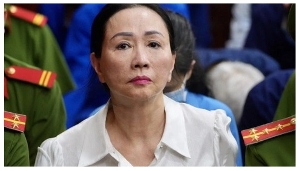 Real estate tycoon Truong My Lan
Real estate tycoon Truong My Lan
A court in Vietnam sentenced real estate tycoon Truong My Lan Thursday to death over her role in a 304 trillion dong ($12.46 billion) financial fraud case, the country’s biggest on record, state media reported.
Her trial, begun on March 5 and ending earlier than planned, was one dramatic result of a campaign against corruption that the leader of the ruling Communist Party, Nguyen Phu Trong, has pledged for years to stamp out.
Lan, the chairwoman of real estate developer Van Thinh Phat Holdings Group, was found guilty of embezzlement, bribery and violations of banking rules at the end of a trial in the business hub of Ho Chi Minh City, state media said.
“We will keep fighting to see what we can do,” a family member told Reuters, speaking on condition of anonymity. Before the verdict he had said Lan would appeal against the sentence.
Lan had pleaded not-guilty to the embezzlement and bribery charges, Nguyen Huy Thiep, one of Lan’s lawyers told Reuters.
“Of course she will appeal the verdict,” he added noting she was sentenced to death for the embezzlement charge and to 20 years each for the other two charges of bribery and violations of banking regulations.
Vietnam imposes the death penalty mostly over violent offenses but also for economic crimes. Human rights groups say it has executed hundreds of convicts in recent years, mainly by lethal injection.
The Thanh Nien newspaper said 84 defendants in the case received sentences ranging from probation for three years to life imprisonment. Among them are Lan’s husband, Eric Chu, a businessman from Hong Kong, who was sentenced to nine years in jail, and her niece who got 17 years.
From perfumes to high finance
Lan started as a cosmetics trader at the central market in Ho Chi Minh City, helping out her mother, she told judges during the trial, according to state media.
She later founded her real estate company Van Thinh Phat in 1992, the same year when she got married, according to state media.
She was found guilty, with her accomplices of siphoning off more than 304 trillion dong from Saigon Joint Stock Commercial Bank (SCB), which she effectively controlled through dozens of proxies despite rules strictly limiting large shareholding in lenders, according to investigators.
From early 2018 through October 2022, when the state bailed out SCB after a run on its deposits triggered by Lan’s arrest, she appropriated large sums by arranging unlawful loans to shell companies, investigators said.
“The defendant’s actions not only violate the property management rights of individuals and organizations but also put SCB under scrutiny, eroding people’s trust in the leadership of the Party and State,” state newspaper VnExpress cited the jury as saying.
The bank is currently propped up by the central bank and faces a complex restructuring under which authorities are trying to establish the legal status of hundreds of assets which were used as collateral for loans and bonds issued by VTP. The bonds alone are worth $1.2 billion.
Some of the assets are high-end properties but many others are unfinished projects.
Before her fall from grace, she had played a key role in Vietnam’s financial world, getting involved in the previous rescue of troubled SCB more than a decade before she contributed to the bank’s new crisis.
She was found guilty of having bribed officials to persuade the authorities to look away, including paying $5.2 million to a senior central bank inspector, Do Thi Nhan, who was sentenced to life in prison.
Vietnam’s graft crackdown, dubbed “Blazing Furnace”, has seen hundreds of senior state officials and high-profile business executives prosecuted or forced to step down.
Corruption is so widespread that in some provinces many people say they pay bribes just to obtain medical services in public hospitals, according to a recent survey by the U.N. Development Program and other organizations.